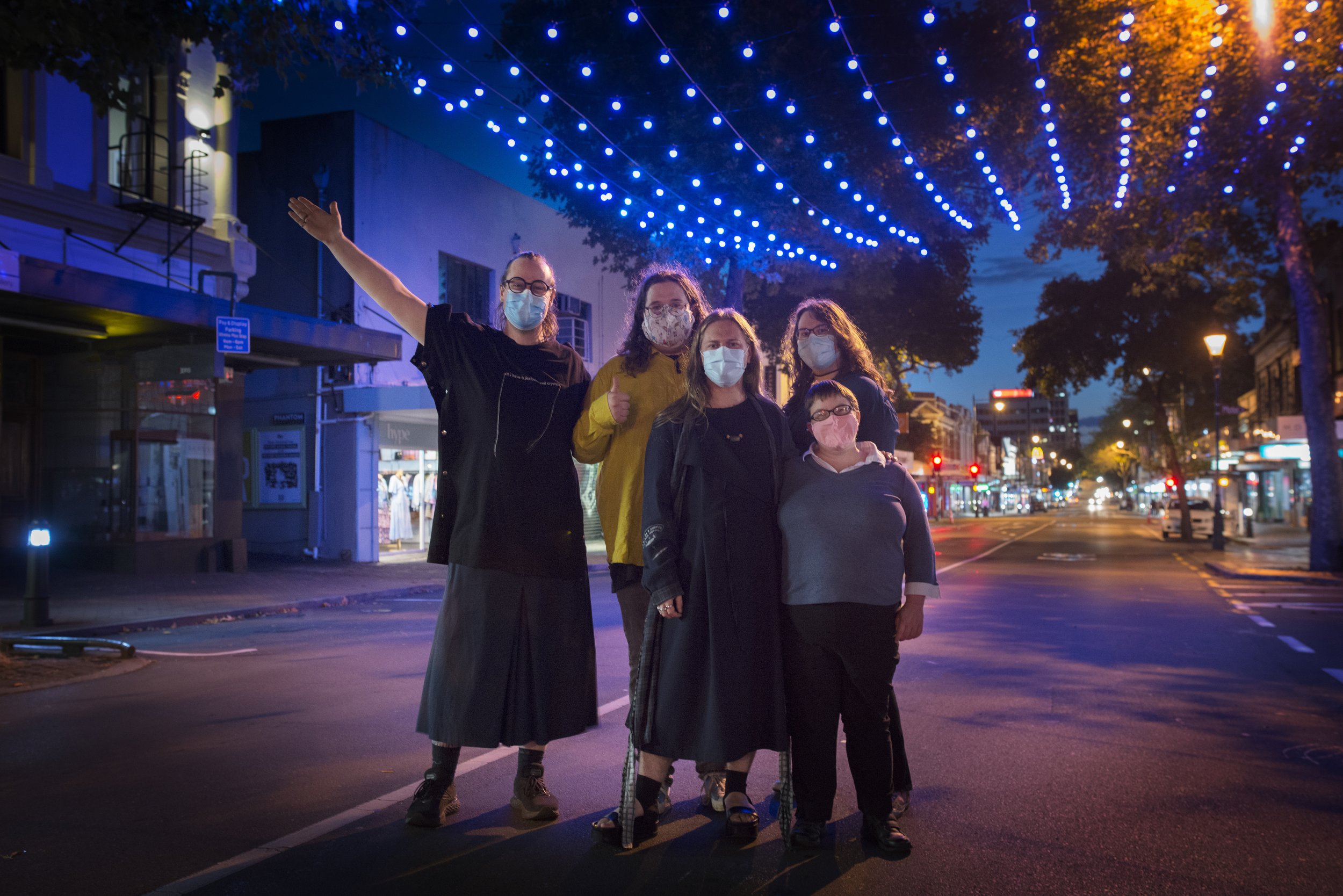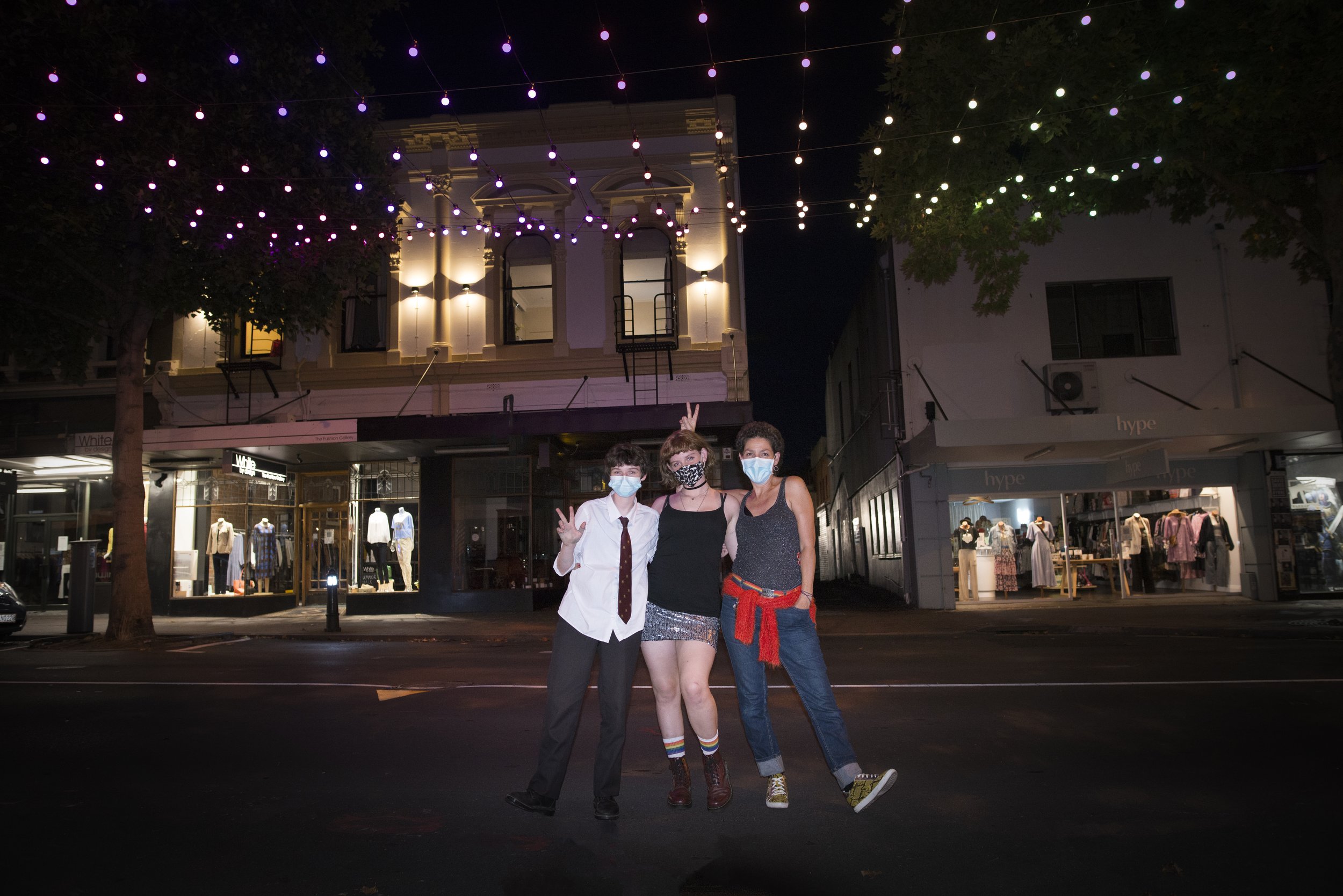Project 61 - Kā Murumura o te Pō Rainbow Aurora (The Platform Project)
Kā Murumura o te Pō Rainbow Aurora
Trak Gray, Max Wolfgram and Dunedin Pride
Images: Justin Spiers
7-31 March 2022
George Street, Ōtepoti Dunedin
Video credit: Walsh&Beck
Rainbow of the Night: A Response to Kā Muramura o te Pō
In the natural world, the rainbow is a phenomenon of light and moisture, most often occurring after rain. It represents a resolution of the tension of a storm, a sign of calm, and an aesthetic beauty that somehow feels magical to witness. The international Pride movement has adopted the rainbow as a symbol of its diversity and unity, best-recognised through various flag iterations, and more recently, pedestrian crossings. In our city of Ōtepoti, the rainbow has been interpreted as a digital artwork in our CBD by Dunedin Pride leaders Trak Gray and Max Wolfgram, the most public and visually-engaging element of our first ever Pride Month. Kā Muramura o te Pō (or Rainbow Aurora) sits within a context that is unique to us, at this moment. As part of the Dunedin Dream Brokerage’s Platform Project which was funded through the Dunedin City Council’s Totally Georgeous project, the work is an initiative to connect people to George Street as it undergoes an ambitious and contentious redevelopment. It also offers us an opportunity to consider our queer history in this city, to wonder at the stories we will never know of queer people lost to time, and to ask ourselves what we want from future representation in this city.
Kā Muramura o te Pō was a digitally-mapped light work, a 150 linear-metre net overhanging George Street, Dunedin’s most well-known central city shopping district. Activated nightly for the month of March, artists Gray & Wolfgram programmed the lights to shimmer with colour and glow, an impressionistic response to ngā kurakura o Hinenuitepō, the Southern Lights. Partners Gray and Wolfgram are relative newcomers to Dunedin, having relocated here in 2019 from Toronto via Auckland, and felt there was a synergy worth exploring between the Aurora Australis and the rainbow that represents the LGBTQIA+ community. The artists connected with Te Rūnanga ō Ōtākou, a vital relationship in the development of the work. Ōtākou shared with the artists te ao Māori significance of the southern lights, and gifted the title of the work. In a wider mythological context, Hinenuitepō, atua or goddess of death, exists in the night sky, receiving human spirits as they die. In that space, Gray drew a parallel to victims of the AIDS epidemic. With a background in working for the AIDS foundation, Gray’s emphasis in their work and in Dunedin Pride moving forward is on community building, and Kā Muramura o te Pō sought to do this by bringing queer people and allies together to experience what Gray calls ‘queer beauty’.
It’s important to understand Kā Muramura o te Pō in the physical and political space of Dunedin’s George Street in early 2022. The Dunedin City Council has embarked on a $28m long-planned redevelopment of the street, to modernise and pedestrianise it, aligning our city with international standards and aesthetics. Incorporating design elements recognising mana whenua and with a focus on pedestrian access, the Totally Georgeous campaign is a forward-thinking and long overdue refresh of our busiest shopping hub, which for years has felt tired, dated, and uninspired. Though there are some dissenting voices in the forms of building owners and retail lease holders, there is a general anecdotal feeling of positivity and support for the redevelopment, and to lubricate the transition, several artworks have been commissioned by the Dunedin Ciy Countil via The Platform Project, including Kā Muramura o te Pō.
The most common feedback Gray and Wolfgram received from people who had experienced their work was the wish that it had extended further down George Street, and that it was permanent. As our city’s urban plan is evolving, it’s worth asking the question: Why is there a void of queer public artwork in our city? The issues are layered, but Gray’s observations of Dunedin’s LGBTQIA+ community may offer the beginnings of some answers, and ways forward.
On arriving here in 2019, Gray found there to be a lack of visibility in Dunedin’s queer community. Specifically, Gray told me, Dunedin lacked ‘the boldness, identity and x-factor’ that fizzes to the top when you have a connected queer community. Gray speaks passionately of their first Pride festival in Germany’s Köln, a city of around 1m, with hundreds of thousands of added visitors for Pride. Gray could feel the feature of being in a city and public space which is ‘queer first’. By contrast, in Dunedin Gray has observed queer people existing in a straight world, and not many queer people existing in queer spaces. Acknowledging that critical mass is an issue (Dunedin’s population is 128,000), Gray feels that it’s difficult to find a large contingent of queer people who want to stay here, and to foster the community. This could potentially be because it might be difficult to meet a partner, or engage with a wider queer scene. Whatever the case, Dunedin has historically had very few ‘queer-first’ moments or spaces, and this is problematic.
From this writer’s perspective, there’s a parallel between the ailing George Street feeling 20 years past its expiry, and our attitude as a city towards the needs of our queer community. Dunedin is simply behind: we lag centres such as Wellington and Auckland, both in attitude and in action, who do understand the value of ‘queer first’. Though we may not have concerns around safety or homophobia as such, we’re certainly not at the point of being a pro-queer city. In no place other than Christchurch has Gray been questioned more as to why Pride is needed. In Dunedin, says Gray, you’re a Dunedin-ite first, queer second.
This may go towards answering the question of why we have no permanent queer artworks in our city. As is so often the case though, the recognition of a problem is the first step in solving it, and moves are being made by members of our community to have our people reflected in Dunedin’s design. The Ōtepoti Rainbow Crossing is one, backed up by the Dunedin International Airport’s installation of a crossing in 2021, and Gray’s plan for a large-scale public artwork for every Pride going forward is another. In that way, Kā Muramura o te Pō is not a standalone work – it’s the first in what will be an annual tradition for our community. “There are a million traditions in the heteronormative world”, says Gray, “but not for queer people.”
‘People’ is the word that Gray lasers in on as they discuss Kā Muramura o te Pō and its purpose. Their collaborative work with Wolfgram is closely related to the new direction of Dunedin Pride, which they took over in 2021: People, visibility, and representation. The night sky as a canvas on which to consider our way forward as a community is an apt one, for many reasons.
Some queer people use escapism as a means to give ourselves a break from a straight world, and especially during that time in our lives when we come to terms with the personal acknowledgement of our own sexualities. I have a close friend who is a self-taught and now professional astronomer, whose obsession with the wider universe began after he was forced to leave home as a teenager, following (unsuccessful but traumatising) ‘gay conversion therapy’. He has described to me the pleasure of looking up at the night sky, and understanding that no matter how overwhelming his problems felt, he was just a grain of dust in a much larger story.
As a queer artist, I’ve also approached the night sky in my work. My 2018 song Matariki was a response to the Māori perspective that our tīpuna never truly leave us, and that we can engage with our lost loved ones through the stars. The comfort that this has brought me is real and powerful, far more so than the intangible Christian concept of ‘heaven’ that I was raised with. The natural world as a means to soothe us in our hardest moments is accessible to us, and is potent.
And so, could Kā Muramura o te Pō could be read as a balm, a work of healing? The trauma that sits with queer people is never far from our realities, and runs deep, regardless of whether or not it’s layered in an armour of resilience and pride. So perhaps if we zoom out, forgetting our notions of time, and look down from above as we become part of the aurora itself, we will see that our queer ancestors walked this land before us. They had their grief, their joy, their relationships, their losses – just as we do. Some thrived, and some just survived. But simply holding the knowledge that we’re not the first and nor will we be the last helps us to create a connective tissue between our queer generations, and hopefully makes our lives just that little bit easier, and more joyful.
With this in mind, Kā Muramura o te Pō is tapping into more than just a symbol of unity, diversity and natural beauty – it’s also an opportunity for us to champion the rainbow as a totem of power, healing, and autonomy, and to manifest a future in which we continue to push for progressive change. In its iridescence we can see the ‘queer first’ city that we want, need and deserve. Could we create a Dunedin that not just accepts and tolerates, but loves, embraces and utilises the differences in our people? The offer is there, and we have the blueprint before us.
By Dudley Benson
























